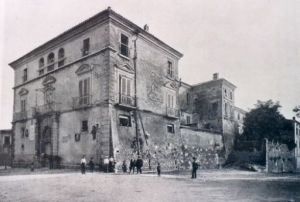Location
Location
In September 1996, the Archbishop’s Seminary in via De Vita 3 was chosen as location of the Archivio di Stato di Benevento. The architectural complex, located in the historic center, is the result of mergers and assemblages of various buildings. The original nucleus was the ancient canonical priory of S. Andrea a platea maiore. The church of S. Andrea was built between 1167 and 1170 by Cardinal Alberto de Morra who later became Pope Gregory VIII.
The establishment of the Seminary
The Seminary was established in 1567 by Cardinal Giacomo Savelli, Archbishop of Benevento and then in 1607 with Archbishop Massimiliano Palombara, nephew and successor of Savelli, the radical renovation and expansion of the building was carried out, incorporating the profane churches of S. Costanzo and S. Zenone. The growth work also continued with Archbishop Giovan Battista Foppa.
The renovations
Unfortunately, the violent earthquakes that struck the city of Benevento between 1688 and 1702 caused severe damage to the seminary. Metropolitan Archbishop Vincenzo Maria Orsini, later Pope Benedict XIII, was responsible for tackling the renovation. Orsini’s successors were equally devoted to keeping the seminary in good repair.
The Pacca Library
Located next to the Archbishop’s seminary, the city’s first public library, the Pacca Library, was built and made active between 1753 and 1755, entirely built at the expense of Cardinal Archbishop Francesco Pacca. The building, although annexed to the seminary, artistically reflects a solemn sixteenth-century austerity in the first part which tends towards rococo in the second part.
The room that housed the library, with a vault entirely covered with a scenic tempera canvas bearing the coat of arms of Archbishop Pacca at both ends, is today reserved for various types of cultural activities, such as conferences, book presentations, etc.
The closing of the seminar
The revolutionary uprisings of 1848 and 1860 led to the closure of the seminary in 1862 by order of the new government which transformed the building into a headquarters for soldiers and Cardinal Domenico Carafa della Spina di Traietto could do nothing to prevent it. In 1880 the doors were reopened to seminarians only after another restoration project.
The new neoclassical look
The current neoclassical style facade is due to an intervention in 1881 which, in order to widen the current Corso Garibaldi, involved the demolition of the facade. With the compensation received, a new floor was also built.

Current headquarters of the State Archives of Benevento in Via de Vita, 3
The historic locations
Pacca marquis palace
The Archivio di Stato di Benevento began its activity in the marquis palace of the Pacca family, an imposing 17th century building, built close to one of the city’s access gates, Porta S. Lorenzo.
The palace, structured on three floors, was inhabited by the noble Pacca family for ten generations, until the early 1900s, and hosted prominent figures in both the ecclesiastical and secular fields.
The building was seriously compromised by the earthquake that hit Sannio and Irpinia on 20 November 1980, which made the main floor reserved for the offices unusable.
The emergency had to be addressed and the staff was transferred to the ground floor, in the warehouses that contained the documentary heritage, fortunately unscathed.

Palazzo Marchionale Pacca, facade before 1943
Building in via dei Mulini
In 1982 the Institute was moved to Via dei Mulini, to a privately owned building of anonymous civil architecture, not particularly suitable as an archive location.
In the following years, the search began for a larger and more functional headquarters that would respond as much as possible to the needs not only of space, necessary to accommodate new deposit, but also of visibility, in consideration of the tendency towards the valorisation of heritage which was increasingly stating.
Last update
10 July 2024, 11:15

 Archivio di Stato di Benevento
Archivio di Stato di Benevento